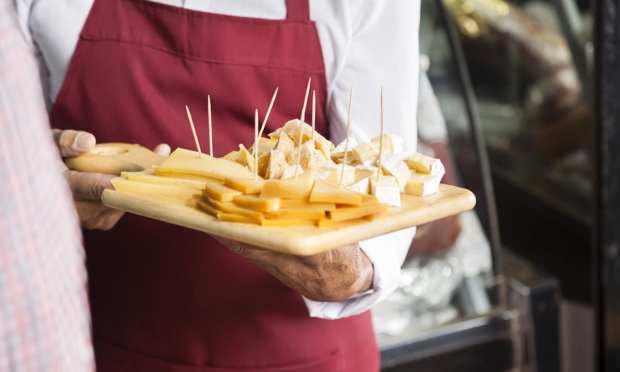Just A Little Taste: Grocery Sampling Makes A Cautious Comeback

In the pre-COVID age, offering in-store free samples to grocery shoppers was one of the most effective ways to push the adoption of new products. Samples could boost products’ sales by as much as 600 percent in some cases. However, in the wake of the coronavirus outbreak, most grocery stores banned in-store samples, and even if they had not done so, consumers in more COVID-cautious locales would have been unlikely to try any samples on offer. Now, as vaccines are rolling out across the country, and as many restrictions are being lifted, retailers are finding ways to work sampling back into the grocery shopping experience.
CPG brand Cure Hydration, for instance, has historically relied on samples at sporting events to drive sales. To replicate this experience, CNBC reports, the company has begun adding products to shoppers’ Walmart curbside pickup orders, which lifted sales without the labor cost of in-store samples. This made Cure Founder and CEO Lauren Picasso suspect that in-store sampling may not be the most effective way to boost sales going forward, even as life settles into a new normal. As she told CNBC, “It ends up being much more economical to get into people’s hands in other ways.”
In Washington, meanwhile, the state’s new apple, Cosmic Crisp, has been seeing disappointing sales, due in part to retailers’ inability to offer consumers a chance to try the premium fruit, reports Capital Press. Now, one retailer is giving away one million free Cosmic Crisp apples, one to each online grocery shopper. Brian Focht, manager of the Washington Apple Growers Marketing Association, said, “Retailers were not displaying it as a premium apple, but putting it in regular displays with all the other bi-colored apples. They didn’t move because they were twice as expensive.” He added that consumers “haven’t had a chance to figure out it is a premium apple.”
Going forward, many experts predict that consumers will continue to be more contagion-conscious than in pre-pandemic times, suggesting that these COVID-borne workarounds will remain useful. One of sampling’s main purposes is to provide confidence in a product, and there are other, less contact-heavy ways to offer this trust. As Jun Group marketing executive Will Braithwaite told MarTech Series, “Free, in-store sampling found a way to move virtual, settling on using influencers to do the sampling for consumers.” This can be an effective tactic even for smaller brands that can only afford to provide the samples themselves, with no additional compensation. A recent report from Bazaarvoice found that 53 percent of samplers are willing to write a review of free products they have received, and 28 percent will post on social media.
These sorts of brand partnerships and ambassador-ships, like in-store sampling, offer a more personal connection to what would otherwise be just another product on a shelf — though it does not replace the experience of tasting a product firsthand. Going forward, industry consultant David Orgel predicted to TODAY, many samples may be individually packaged. Additionally, “some retailers may adopt a hybrid approach, such as with both packaged and non-packaged. Regardless, it will be important at first to relay safety measures to shoppers so they feel comfortable re-engaging.” Similarly, epidemiologist Shira Doron, MD predicted to the publication, “There will probably be modifications to how they are offered, perhaps even rules in place, like a requirement for sneeze guards or that they be handed out by a trained employee.”
Industry experts predict that it may be a year or more until in-store samples return to a form that more closely resembles the pre-COVID experience. In the meantime, online and curbside order add-ons, influencer posts and individually packaged samples will continue to drive sales and build trust with consumers, and more contagion-conscious sampling tactics may develop in the near future.
